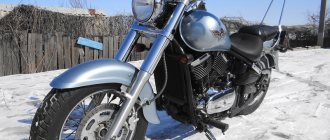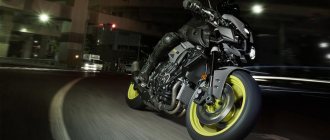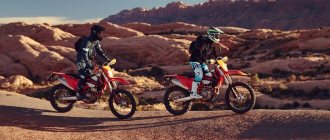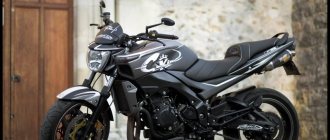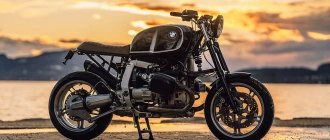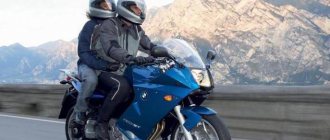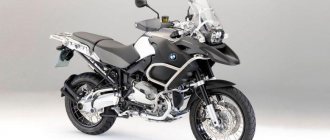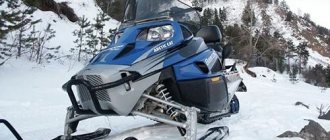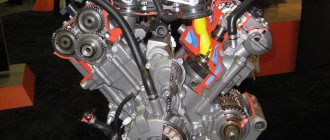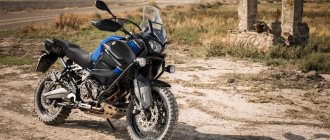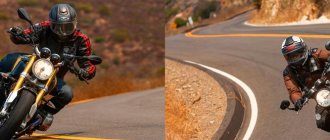One fine morning you woke up and realized that you want to get on a motorcycle and ride off beyond the horizon, and not just for one day, but to go on a real “long-haul” trip! Then, in any case, you will have to choose among the so-called tourist enduros.
In this segment, some of the most popular models on the used market for $4,500-$5,000 are the Suzuki V-Strom 1000 (aka Kawasaki KLV1000) and BMW R1150GS. Which one should you prefer? A comparative test was conducted by our motorcycle traveler Alexander Dezhkunov.
What are we comparing?
The first test subject for comparison is the Kawasaki KLV1000 2004. Let the name not be misleading - this is the same Suzuki V-Strom 1000, which was produced in parallel at the Suzuki plant in 2004-2006, but only under the Kawasaki brand and in orange. Thus, Kawasaki filled the tourenduro niche that was empty for several years. We will compare this motorcycle with the BMW R1150GS 2001.
The total mileage of the “Japanese” is 100,000 kilometers, of which the first 50,000 were covered in the homeland of BMW, and the second were driven by me since 2014 on long-distance trips on roads of varying degrees of severity. The German has the same 100,000 kilometers, but he arrived quite recently from his historical homeland and, judging by the excellent condition, he saw only his own native roads. A run of around 600 kilometers on the highways of the Republic of Belarus and about 100 kilometers around the city in a BMW is, in principle, enough to evaluate the main features of the model.
Engineers have completely different views on solving the same problem. The Japanese classical school of motorcycle building against the gloomy German genius with original solutions. Well, let's start with the comparison.
Aluminum vs steel
The taste and color, as they say, are different, but the general tendency is that Kawasaki is perceived by most as rather neutral - a motorcycle and a motorcycle, except that from the front, thanks to the large double headlights, it resembles a scooter. But BMW, due to its specific appearance (especially its large “beak”), often divides people into two categories: some like it, others consider it ugly.
In the photo, the motorcycles are in stock, with the exception of the central panniers, frames for the side panniers and front guards - on Kawasaki it underwent “tuning” after an encounter with a taxi in Bishkek (the front cracked part was simply cut off with an angle grinder), on BMW the “beak” is supplemented with an expanding pad, which improved the appearance somewhat. Although on Kawasaki the seat was reupholstered, which definitely added comfort to the fifth point.
Regarding the “body”: the “Japanese” is assembled on an aluminum frame, the “German” – on a steel one. Both are quite strong and can withstand vibrations and loads, including hanging large and heavy cases. The plastic on the BMW feels stronger and should be better able to withstand various drops.
The riding position on motorcycles is slightly different. With a height of 185 cm on the Kawasaki, the back is absolutely straight, the footpegs are located at such a distance from the seat that the angle of bend of the legs at the knees is approximately on the border of “comfortable-uncomfortable”. In general, the seating position is comfortable, which is especially important for long trips. The seat on the Kawasaki is one-piece and is not height adjustable.
With the same height, a BMW already has a slight forward tilt of the body. Despite the fact that the seat on the BMW is separate and the driver's part can be installed in two height positions, it was not possible to get comfortable. The footrests are located in such a way that in the lower position the knees are strongly bent, in the upper position it is already better, but after a while you also begin to feel discomfort. The height of the seat from the ground on both motorcycles is approximately the same - with the indicated height, both feet are completely on the asphalt during stops.
Comfortable seating is one of the main conditions for comfortable travel. In any case, you need to try on each motorcycle for yourself. To select the main models, you can use the website cycle-ergo.com, where you can “try on” your parameters on all models of motorcycles and look at the fit, body angles and limb bends.
In terms of the convenience of motorcycles for the second number, the situation is similar. The Kawasaki is a little more comfortable.
Wind protection with standard glass is clearly in favor of Kawasaki - the wind flow is completely cut off. On a BMW, the “effect of presence” on the highway is quite strongly felt - for complete comfort on long trips, it is recommended to replace the glass with a larger, tuned one.
Visibility in the standard rear-view mirrors is also better on the Kawasaki due to its larger size.
The instrument panels of both motorcycles are similar: with classic dials for speed and engine speed, quite easy to read. A definite plus of the BMW panel is that the gear indicator is already “in the database”.
For me personally, the option is quite useful, so the indicator is installed additionally on Kawasaki.
Another plus of BMW is the standard heated grips, which work correctly even almost 20 years after the motorcycle was released. The option will undoubtedly be useful when traveling on cool spring and autumn days, as well as in the mountains and during rain.
When designing the controls, Bavarian engineers for some reason decided to move away from the classic design of the direction indicator remote control. “They were original” very much - I’m sure that he has been hiccuping with it constantly for decades. You can get used to anything in life, but not to this remote control. Probably the worst decision in this motorcycle. If “for everyone” one “three-way” button under the left thumb is responsible for turning on/off, then at BMW three buttons located on the left and right remote controls are responsible for these operations. The main inconvenience is in using two right buttons: while turning the throttle, it is very difficult to blindly hit the required button with the thumb of your right hand.
Both wheels are tubeless, but the Kawasaki has cast wheels, and the BMW has spokes. If you prefer to avoid potholes when riding, then Kawasaki alloy wheels should not cause problems.
No need to tighten the spokes - the choice of the lazy. But “casting” is practically impossible to repair and is not at all cheap, and if you want to “unscrew” over holes and asphalt cuts in rally mode, the spoked wheels of the “German” are clearly preferable.
The cantilever mounting system for the rear wheel on BMW is not a particular advantage with tubeless tires - ordinary punctures are “treated” with a flagellum without removing the wheel.
Model designation
BMW uses a three-segment nomenclature for motorcycles. The first segment indicates the engine type, the second the approximate engine displacement in cubic centimeters (with one notable exception: the F 650 GS, which has an engine displacement of 798cc [37]
), and the third class is a motorcycle (for example, sport, sport touring, dual-sport, etc.). The three segments are separated by spaces.
A similar 3-segment nomenclature is used for BMW vehicles. However, with respect to the second segment (engine displacement/100), there is significantly less consistency across the entire range.
Engine's type:
- R-air-cooled, horizontally opposed (
- K-water cooled, in-line 3-, 4- or 6-cylinder
- F-water cooled, vertical 1-cylinder (before 2006), vertical 2-cylinder (after 2006)
- G-water cooling, vertical 1-cylinder
- S-line 4-cylinder water-cooled superbike
Engine capacity in cubic meters cm:
- Current models are 1600, 1300, 1250, 1000, 900, 800, 650, 400 and 310. Previous models included 450, 850, 1100, 1150 and 1200.
- Older BMW models divide the approximate engine size by ten for the model number. For example, K75 ≈ 750 cc. cm.
Styling suffix notations:
- B-Bagger
- S-Cruiser
- CS-classic sport
- G/S-Gelände / Strasse Off-road / Street
- GS-Gelände Sport off-road sport (enduro)
- GT-Gran Turismo or Grand Touring
- LS-Luxury Sport
- LT-Luxus Tourer (luxury Tourer)
- R-Road or Roadster is usually naked
- RR racing replica
- RS originally stood for Rennsport, but from 1976 came to stand for Reisesport[41]
- RT-Reise Tourer (tourist Tourer)
- S-Sport
- ST-Strasse (street) or Sport Tourer
- T-Touring
In addition, a bicycle may have the following modifiers in its name:
- ABDOMINAL PRESS
- L-luxury
- P-police
- C-custom
- PD-Paris Dakar
Examples: K 1200 S, R 1200 RT, F 650 GS, R 1150 RSL, K 1200 LT, K 1200 LT-C, R 1200 RT-P, R 1200 RSA, S 1000 RR.
Until the introduction of the K 100 series and R 1100 series motorcycles, the letter prefix was always the same. And the numbers were either based on displacement. As mentioned above. Or they were just model numbers.
Rear suspension
Single-sided rear suspension
The first BMW monolever suspensions appeared in 1980 on the then new R80G/S line. It had a single universal joint just behind the engine/transmission. This system was later included in updated versions of the K&R series.
Paralever
Paralever is another step forward in BMW single-sided rear suspension technology (photo right). It unleashes the torque response as the suspension compresses and extends. Avoiding the tendency to squat or rise when accelerating and reducing tire chatter on the road surface. It was introduced in 1988 with the R 80 GS and R 100 GS motorcycles.
Corrected, inverted Paralever on R1200GS
In 2005. Along with the introduction, this reduces the overhang of components and tends to increase ground clearance in a right-handed lean position.
The figurative term for the lever is a swing arm, and other motorcycle manufacturers have patented similar designs. Including the Arturo Magni for MV Agusta and Magni-Moto Guzzi machines, as well as the compact Moto Guzzi jet shaft drive.
Front suspension
Telescopic fork
In 1935, BMW installed the first production hydraulically damped telescopic fork on its R12 and R17 motorcycles. BMW still uses telescopic forks on its F-series, G-series, HP and S1000RR motorcycles.
The R series, which for several years used only Telelever and Duolever front suspensions,
made a partial return to telescopic forks for the 2015 model year with the introduction of the R 1200 R and R 1200 RS.
[42]
Earls fork
Earles fork on BMW R60/2
The Englishman Ernest Earls developed a unique triangulated fork, which, unlike telescopic forks. Resists lateral forces. Created by strollers. BMW has fitted Earles forks to all of its models for 14 years. Since 1955. In this case, it was the year that stroller use peaked and fell quickly in most European markets (eg UK). But the Earles fork system was also a big hit with solo riders. This causes the front end of the motorcycle to rise when braking - the reverse action of the telescopic fork. The mechanical strength of this design sometimes proved to be a weakness for the rest of the bike. Since it transmitted shock pressure to the frame. Where the damage was more difficult and expensive to repair.
Fork
BMW Telelever front suspension on R1150R
Developed by Saxon-Motodd in the UK in the early 1980s, the Telelever fork aims to improve handling stability when cornering and braking. Telever uses conventional telescopic forks, but the struts only contain lubricating oil. The springing and damping functions are performed by a monoblock attached to the wishbone. The wishbone pivots on the front of the engine block, and the front end of the wishbone attaches through a rose hinge to the bracket. Connecting fork sliders. Because there is no lower triple clamp, the fork sliders are longer and lighter than on a conventional telescopic fork. And greater slider/tube overlap reduces how torsional bending occurs. So is the unsprung weight.
The main advantage of the Telelever system is that... That it separates the steering function from the braking functions and the suspension, the braking forces are retracted rearward through the wishbone. Thereby eliminating brake dive. During braking, the angle of inclination of the caterpillar and wheel (rake) increases, not decreases. Same as with traditional telescopic forks. Some riders accustomed to conventional forks have reported. What Telever may initially lack [46]
but the R1100s BoxerCup Replika (model with its own racing series) shows. That the Telelever fork provides responsive and predictable handling.
The term is a figurative word from
Duolever
Duolever pendant top
In 2004, BMW announced the K1200, which included a new front suspension. Based on a design by Norman Hossack. [ 48]
BMW admitted this fact, but did not pay Hossack any fees.
[49]
BMW named its new front suspension Duolever. From 2021, Duolever is available on all K1300 and K1600 models.
The official explanation of BMW Motorrad duover includes the following:[50]
The advantage of this front wheel suspension in the motorcycle market today is its torsional rigidity. The front wheel suspension of the BMW Motorrad Duolever is not affected by negative forces in the same way as conventional telephores. Fixed and take-off tubes which rotate in the lateral and longitudinal directions during jerk/rebound and steering. Its two tail links absorb shock/rebound forces and maintain wheel support stability. Thus, any torsion is eliminated and the front wheel suspension is very precise. The rider's steering commands are translated directly. And feedback from the front wheel is transparent in all driving conditions.
A kinematic anti-dive effect is additionally achieved. As for Telever, due to the location of the rear link bearings. While a regular telefork sways or gets blocked during strong braking maneuvers. The Duolever still has plenty of spring travel. Remaining in this situation. And so the rider can still brake into the corner very late. But in the direction of sustainability.
- ^ a b
Deliveries as of December were 10.9% higher than the previous year. BMW Motorrad's strategy takes effect. Archive from the original on 2016-09-27. Retrieved 2016-09-26. - . autoevolution.com May 13, 2011. Archived from the original on May 19, 2011. Retrieved May 13, 2011.
- Downs, Andy (November 11, 2015). . News About Motorcycles
. Archived from the original on February 1, 2021. Retrieved January 30, 2021. - Sunny, Ken (November 12, 2015). . International Business Newspaper Archived from the original on March 5, 2021. Retrieved January 30, 2021.
- . Production capacity
. BMW Group. Archived from the original 2008-12-11. Retrieved 2008-09-18. - Ash, Kevin (January 30, 2012). . News About Motorcycles
. Archived from the original on May 2, 2012. Retrieved July 15, 2012. - . Visiondown
. January 30, 2012. Archived from the original on February 4, 2012. Retrieved July 15, 2012. - Madson, Bart (January 30, 2012). . Motorcycle USA
. Archived from the original on February 1, 2014. Retrieved July 15, 2012. - . webBikeWorld.com February 5, 2010. Archived from the original on May 13, 2010. Retrieved February 18, 2010.
- . Biker Voodoo. Archived from the original on 2008-05-06.
- Ziegler, Jessie. . Motorcyclist. Archived from the original on December 29, 2008. Retrieved 2009-01-07.
- . China Economic News Service (CENS). July 3, 2008. Archived from the original on February 21, 2009. Retrieved 2009-01-09.
- . Visiondown. Archived from the original on February 21, 2009. Retrieved 2009-01-09.
- Brisette, Pete (December 15, 2008). . Motorcycle.com archived from the original on January 30, 2009.
- Madson, Bart (July 2, 2010). . Motorcycle USA. Archived from the original on July 5, 2010. Retrieved July 22, 2010.
- Organization, A.S.O.-Amur Sports. . www.dakar.com
. archived from the original on 2016-09-19. Retrieved 2016-09-18. - (PDF). Dakar. Archived from the original (PDF) in 2010-06-01. Retrieved 2009-01-07.
- . Motorsport Etc. Archived from the original on December 27, 2008. Retrieved 2009-01-07.
- . carolenash.com
archived from the original 2018-03-26. - . www.press.bmwgroup.com
archived from the original on December 20, 2021. Retrieved May 9, 2018. - . www.iomtt.com
. Archived from the original on August 28, 2021. Retrieved May 9, 2018. - (PDF). Archived (PDF) from the original on 06/2016/15. Reviewed 2016-06-04.CS1 maint: archived copy as title (link)
- . www.iomtt.com
. Archived from the original on August 23, 2021. Retrieved May 9, 2018. - Omorogbe, Jane (April 3, 2008). . MSN. Archived from the original on July 23, 2011. Retrieved November 11, 2009.
- https://classic-motorbikes.net/wp/bmw-r90s/
- ^ a b Which Bicycle
: 39. Summer 2004. - Cameron, Kevin (December 21, 2012). . World of Cycle. Retrieved June 27, 2021.
- Brown, Roland (February 2, 2014). . Telegraph.
- . BMW Motorrad Germany
(in German). Retrieved 2020-04-04. - Ker, Rod (May 2005). . Morton Way, Horncastle, UK: Mortons Media Group. Archived from the original on 05/02/2013. Retrieved 2013-05-23.
- BMW Archived 2019-04-20 on the BMW Wayback Machine technology website
- Madson, Bart (July 2, 2010). . Motorcycle USA. Retrieved July 22, 2010.
- ^ A b c
Hull, Matt.
RiDE Magazine
(September 2010): 123. ISSN 1360-3507. - Madson, Bart (November 10, 2009). . Motorcycle USA. Retrieved July 22, 2010.
- Ash, Kevin (25 August 2010). .
- . Archived from the original on 2016-03-03. Reviewed 2020-06-25.CS1 maint: archived copy as title (link)
- BMW Motorrad Deutschland Archived 2008-03-15 at The Wayback Machine
- BMW motorcycles: bikes: F 650 GS Archived 2008-03-02 at The Wayback Machine
- . Archived from the original on 2016-08-09. Retrieved 2020-06-25.
- BMW Motorrad (6 October 2008). . Motorcycle.com. Retrieved November 19, 2012.
- Wilson, Byron (September 30, 2014). . MotorcycleUSA.com
archived from the original 2014-11-11. Retrieved 2014-11-11. - Falloon,
original BMW air-cooled Boxer Twins 1950-1996 , pp 13-14 - Holmstrom & Nelson
, p. 64 - Patent GB693646, Earles, Ernest,
- . Visiondown
. September 14, 2010. Archived from the original on December 26, 2014. - What Bicycle?
: 41. Summer 2004. - . Design by Hossaka. Retrieved March 22, 2010.
- Archive 2018-09-04 on the Wayback machine, broughsuperiormotorcycles.com
- . BMW Motorrad. Archived from the original on June 26, 2006. Retrieved March 22, 2010.
Emotions vs. calmness
Let's start with Kawasaki. The engine is perhaps the main contradiction of this motorcycle. Paradoxically, as good as he is, he is just as bad. V-shaped twin with a camber angle of 90 degrees, volume 996 cc. cm and liquid cooling, borrowed from the Suzuki TL1000 sportbike, derated to 98 hp. and produces 101 Nm of torque. There are additionally electronically controlled air dampers at the intake, which try to smooth out the nervous engine. Although the engine has been retuned and added low-end and mid-range, it starts to run only after 3000 rpm. Before this, there were some confused twitches. 3500-5000 – the most comfortable speed. Further, with increasing speed, there is more sound rather than acceleration.
It turns out that if there is a fairly wide speed range, the engine operates optimally in a rather narrow one. The sound of the engine itself is also not so great - some howling, clanging, squeaking. For Honda, such sounds would definitely mean the death of the engine. But structurally this engine is like that. The gears are also selected specifically - the gap between them is large during quiet driving. For example, to drive a conventional 25-30 km/h, you need to either keep the speed in the region of 4000-4500 rpm in first gear (which is already quite noisy), or engage second and “twitch” with insufficient traction in second gear at 2500 rpm /min.
For the city (namely quiet driving) this engine is bad. He asks for the gas to be opened. Requests acceleration. Like a thoroughbred horse racing. If you limit her to a trot, it will be unusual for her - she will twitch and get confused. But as soon as they let her gallop, this is where she opens up. If you ride a Kawasaki with constant acceleration, clicking through the gears, this is its element. Or the track. That's where he's beautiful. Sixth gear, 120-140 km/h – it’s comfortable to drive in this mode for hours. If necessary, turn the throttle and confidently accelerate and overtake.
The reliability of the engine is not bad - with normal handling, a mileage of 200,000 kilometers is not the limit for it. Among the features: checking and, if necessary, adjusting valve clearances with washers every 24 thousand kilometers according to the manual (from experience: the gaps go over 50 thousand), the pump begins to leak after about the same 50 thousand kilometers and the timing chain requires replacement after about 100 thousand kilometers. Otherwise standard service.
Air-oil-cooled boxer two-cylinder engine with a capacity of 1130 cc. cm, power 85 hp. and 98 Nm of torque from the German competitor is a completely different story. Sounding pleasantly, driving confidently and at 2000 rpm, evenly spinning up to the second half of the tachometer marking - this engine is perfectly suited to the measured philosophy of a tourenduro.
The difference in power reflected on paper is felt on the road. And if in the city the BMW is just not as dynamic when accelerating compared to the Kawasaki (but you don’t want to spin the BMW at all), then at speeds of 110-130 km/h the Bavarian’s engine is a little lacking. With uniform linear motion there are no questions. But when adding “gas” during the same overtaking, there is no that responsiveness and slight undermining, there is no obvious “desire” of the motorcycle to accelerate. Yes, it accelerates, but not as readily as the Kawasaki. So the BMW engine limits emotions on the track. But in all other modes it is excellent.
Smoothness – the absence of a “peck” either at the moment of opening the gas or at the moment of resetting, as is the case with Kawasaki – allows for a more relaxed handling of the throttle, and also does not impose additional demands on the passenger. The sound of the engine at low speeds in the city does not strain the ears. Smooth traction allows you to ride more confidently on ups and downs. In general, for a relaxed driver, the BMW engine is definitely better. And the resource, along with ease of service, is also on the side of the “Bavarian”.
Power supply system - injector. Both in “Japanese” and “German”. But on BMW it is structurally quite “ancient” - during engine warm-up, the speed is regulated by a mechanical lever a la “carburetor choke”. But injectors on BMW, in case of need for maintenance or replacement, are located more conveniently; in the case of Kawasaki, getting to them is oh so difficult. Fuel efficiency in my case, with uniform straight-line movement along the highway at a speed of about 115 km/h, was on the side of the Kawasaki - 5.2 l/100 km versus 5.6 l/100 km for the “Bavarian”. But in principle, such a difference can be neglected - each rider will have his own numbers, depending on his driving style. With the same volume of fuel tanks (22 liters) and a leisurely pace of movement, a power reserve of 300 kilometers between fill-ups is provided to both.
Exhaust. The Kawasaki has two mufflers versus the BMW's one, and the Kawasaki's exhaust sound is richer. But taking into account the ringing and rattling sound of the Japanese engine, there is parity between the two models in terms of the overall sound background.
Both have a hydraulic clutch drive, but the clutch itself on Kawasaki is a “classic motorcycle”, multi-disc in an oil bath, while on BMW it is a single-disc dry one (like on cars). You will have to get rid of the habit of “poisoning” the clutch on a BMW - a dry one does not like such treatment. But on a Kawasaki you will have to press the clutch lever very often - it is most convenient to smooth out the harsh nature of the engine in this way.
The reliability of both designs is high, with the exception of the clutch slave cylinder that sometimes leaks on Kawasaki (early years of production). The reason is the insufficient area of the boot and the penetration of sand onto the cylinder walls. Over time, the problem was solved by installing an improved boot. An undoubted advantage of the BMW dry clutch is that the engine can be filled with ordinary automobile oil, which has a much lower cost. And you can find replacement oil anywhere while traveling.
The type of rear wheel drive also differs on motorcycles: on Kawasaki - a chain, on BMW - a cardan. In principle, in every sense, the cardan is better (if you don’t force the motorcycle in extreme conditions and don’t get into the mud up to the saddle) - the lack of need for maintenance/replacement of the chain, especially when traveling, is worth a lot.
However, when it comes to a heavily used motorcycle, not everything is so simple. A set of high-quality sprockets and chain is enough for 30 thousand miles; a good chain practically does not require tightening during its entire life. And here you should give preference yourself: the risk of failure of an expensive unit or guaranteed peace of mind, but more effort in washing/lubricating the chain. Plus, the feeling of riding (and especially starting from a stop) on motorcycles is different: the faster-grabbing dry clutch of the “German” in conjunction with the cardan does not provide the softness of torque transmission that the “oil bath + chain” provides. But in terms of practicality, the cardan is a thing.
Current production
BMW's best-selling motorcycle, the R1200GS
BMW K1200S
2014 BMW S1000R
With the exception of the G310 series (which is produced at the TVS plant in Tamil Nadu, India), all production of BMW Motorrad motorcycles takes place at its plant in Berlin, Germany.[6]
some engines are produced in Austria. China and Taiwan.
Most of the current motorcycles in the BMW Motorrad line were designed by David Robb, who was the company's chief designer from 1993 to 2012. When he was replaced by Edgar Heinrich.
The most popular model is the R1200GS and its brother R1200GS Adventure. Which sold 24,467 units. Which represents 28% of BMW's annual production. [10]
Modern production includes various models with shaft, chain and belt drive. With engines from 310 cc. cm up to 1802 cc cm; as well as models. Designed for off-road, dual-purpose, sports and tourism activities.
In 2008, BMW introduced the DOHC Boxer HP2 Sport,[11]
and entered serious competition into the off-road motorcycle market with the launch of the BMW G450X motorcycle.
BMW Motorrad motorcycles are divided into product families, and each family is assigned a different letter prefix. The current families are as follows:
- Series C-Maxi scooters called urban mobility vehicles from BMW
- F Series 798 cc parallel twin engines. cm, equipped with a chain or belt drive. Models F650GS, F700GS, F800GS, F800R, F800S, F800GT and F800ST. The F650GS was powered by a single-cylinder 652cc Austrian Rotax engine.
- G series - single-cylinder engines with volume from 449 to 652 cc. cm with chain drive. Models g450x (now discontinued), G650GS, G650 Sertão, G650 Xmoto, G650 Xchallenge and G650 Xcountry. 450 cc engines cm are manufactured by Kymco in Taiwan. [13]
650 cc engine parts. CM 2009 and 2010 were manufactured by Rotax in Austria. And the engine was assembled by Loncin Holdings, Ltd in China. arriving in 2021 BMW G310R, single-cylinder liquid-cooled model. Manufactured in India by TVS Motor Company. - R series - two-cylinder boxing engines with a displacement of 1170 cc. cm with shaft drive. Models
r1250gs, R1200GS, R1200R, R1200RT, R1200RS, R1200S, R nineT and R18.
- K-series four-cylinder engines ranging from 1157 to 1649 cc. cm with shaft drive. Models K1200LT, K1300GT, K1300R and K1300S. in 2011, BMW Motorrad released a six-cylinder 1,649 cc. see K1600GT and K1600GTL. [16]
- S series-S1000RR—cross-mount sports bike, 999cc cm inline four-cylinder engine. Models included S1000R, S1000XR
BMW Motorrad achieved record sales for the fifth time in a row in 2015.
In 2015, a total of 136,963 vehicles were sold. And BMW sales increased by 10.9% compared to 2014. Germany was again the largest single market in 2015 (23,823 units), followed by the USA (16,501 units). France (12,550 units). Italy (11,150 units). UK (8,200 units) and Spain (7,976 units).
Aiming to deliver 200,000 vehicles to customers by 2021. BMW Motorrad plans to increase its dealership from approximately 1,100 to 1,500 vehicles in the future. As has been the case until now, BMW's most successful motorcycle is still the R 1200 GS with 23,681 units sold in 2015.
| This section needs expansion . |
BMW Motorrad regularly competes with its motorcycles in the Dakar Rally, an annual car, truck and motorcycle race. Traditionally taking place on European and African soil. And recently in South America [17]
such racers were presented. Like Simon Pavey and motorcycling celebrity Charlie Boorman. BMW Motorrad motorcycles have won the Dakar Rally six times.
In 2007, BMW Motorrad announced its entry into the 2009 World Superbike Championship season
year, launching its S1000RR bike. The factory team for the 2009 season was known as Team Alpha BMW and included Spanish driver Ruben Xaus and Australian driver Troy Corser. [20]
In the 2010 season, Xaus and Corser were joined by Reitwagen BMW team drivers Andrew Pitt and Roland Resch. Also rode the S1000RR.
Isle of Man TT
In recent years, BMW Motorrad has enjoyed renewed success at the Isle of Man TT. Until 2014, the last success in the solo categories at this event was in 1939, when Georg Meyer won the senior TT. After 75 years, BMW again took first place on the podium in
2014 Isle of Man TT, when Michael Dunlop piloted a BMW S1000RR to first place in the opening superbike race. Michael Dunlop then ended the week with a win in the Senior TT. [21]
At the 2021 Isle of Man TT, Michael Dunlop once again took pride of place in the first Superbike TT for BMW. Dunlop led the race from start to finish from another BMW driver, Ian Hutchinson. Dunlop also set a new outright lap record of 133.962 mph (215.591 km/h). [22]
and set a new race record of 1 hour 44 minutes 14.259 seconds.
After 226 miles (364 km) of racing. [23]
BMW sidecars also had numerous successes in TT racing, mainly in the 1960s and early 1970s.
In total, BMW has won 34 Isle of Man TT races, in both the single and sidecar divisions.[24]
Parity on suspensions, defeat on brakes
The design of the pendants is also different. To put it briefly and “in popular terms”, on Kawasaki there is a “regular” suspension, on BMW there is a “specific dive” when braking the motorcycle. Both there and there are mechanical adjustments.
The suspension feels like it works great on both motorcycles, but when the Kawasaki is fully (or rather overloaded), it lacks a little stiffness when the adjustments are fully tightened. However, this is more of a nitpick. The “anti-dive” on a BMW is especially pleasing during city driving. When driving on the highway, the Kawasaki suspension smoothes out uneven surfaces a little better.
The main disadvantage of Kawasaki is ground clearance. When the motorcycle is loaded, it is clearly insufficient, and when the center stand is installed, it becomes even smaller. The rear suspension adjuster clamped all the way does not help much - periodic contacts of the “bottom” with the road surface are ensured. The solution is to install “spacers” that increase the ground clearance by 1.5-2 cm, which you can even make yourself from a sheet of thick metal. It is advisable to increase the ground clearance immediately after purchase, if this has not been done before. In my case, the final understanding came “somewhere out there” after the center stand was torn off from its mounting again.
When it comes to braking systems, the clear leader is obvious. And it’s not even about ABS, which, unlike Kawasaki, is present on the Bavarian. The engineers from Brembo certainly do not eat their bread in vain. The brakes on BMW are so perfect in their work that after them on the “Japanese” it’s as if there is no rear brake at all, and the front one is trying to slow something down.
On the 1150th “Goose”, depending on the year of manufacture, two types of brakes were installed: a more archaic design of the first generation with rough ABS operation, but quite reliable, and a more recent second generation, which very often fails and is very expensive to “treat” . But even without ABS, the brakes on the “German” are amazing. After using a BMW on a Suzuki in the city, you have to change your driving style and start slowing down much earlier.
Engine types
There are four lines of BMW motorcycles:
- F&G series singles
- Gemini F series
- R-series
- K-series
The series differ primarily in the class of engine that each of them uses.
Series F and G singles
The F series of single-cylinder BMW motorcycles was first launched in 1994 as the F650, and was built by Aprilia around a carbureted 650 cc four-stroke. Four-valve. Single piston engine and chain drive.
The mission of the F 650 was to provide an entry-level BMW motorcycle. In 2000, the F650 was redesigned, now with fuel injection, and designated the F650GS. The same year the off-road model F650 Dakar was released. In 2002, the F650CS Scarver motorcycle was added to the line, differing from the F650GS variants in themes. That it used a belt drive system. The opposite of chain. It had a significantly lower seat height and was intended for road use. All F650 motorcycles produced from 2000 to 2007 used a 652 cc engine built in Austria by
Rotax and built by BMW in Berlin.
At the end of 2006, the G offroad biased Bikes series was released, using the same 652 cc engine. Installed on F650GS. Although this engine is no longer manufactured by Rotax. The latest version of the 652cc single-cylinder engine found in the new G650GS. Now produced in Berlin after 2 years of production in Lonczyn, China.
In November 2007, the G450X sports enduro motorcycle was launched with a 450 cc single-cylinder engine. see The G450x contained several technological improvements over the Japanese off-road racing motorcycles. But the most unusual and significant was the use of one pivot point for the leading
sprocket and swing arm. This unusual configuration allowed the drive chain to be very tight without slop and eliminated squat acceleration. The first benefit saves chain and sprocket wear. And the second provides a more consistent drive geometry and fully accessible rear suspension travel under heavy acceleration.
Gemini F series
In mid-2006, the F Series added two new motorcycles to the lineup - the F800S sport bike and the F800ST sport tourer. Both of which use the 798cc
parallel twin engine built by Rotax. Both bikes also feature a belt drive system similar to the one used on the F650CS. In 2007, the single-cylinder F650GS was replaced by the twin-cylinder F800GS and F650GS models. The latter uses a de-tuned version of the 798 cc engine. Installed on F800GS, [25]
marking a departure from BMW's naming convention.
Flat Gemini R Series
Four different BMW airhead and oilhead valve covers
Valve cover 1954 R68 with two fins
The R series is built around a horizontally opposed
flat twin engine (boxer). Because the engine is mounted with a longitudinal crankshaft, the cylinder heads extend well beyond the sides of the frame. Initially, the R series bikes had air-cooled heads. But now they are produced only with partial oil cooling or water cooling. A type of internal combustion engine cooling used in various R-series engines. Leads to the use of the distinctive names airhead and oilhead.
Airheads
- These are BMW motorcycles with a vertical single or horizontally opposed dual air-cooled engine. Which were built from 1923 to 1995.
Most airheads made from 1969 to 1995 used the BMW 247 engine, although 248/1 engines were used on the mid-range R series motorcycles from 1978 to 1993. Even high performance motorcycles like the R90 used the 247 engine [26]
, and its successor, the R100RS. Was equipped with an oil cooler.
Oil
is a name to describe BMW's flat-twin partially oil-cooled motorcycle engines and to distinguish these engines from earlier air-cooled models
The finned oil head cylinders are conventional air cooled, but the four valve cylinder heads are oil cooled. Unlike earlier BMW boxers which had a single camshaft in the crankcase (variably above or below the crankshaft). The oil head has a camshaft in each head. (Technically, this is still an overhead valve engine. Not a true overhead camshaft block. Because the camshaft is supported by very short pushrods, which operate the valve rocker arms). In 2013, BMW introduced water cooling to its boxer line.
the engine is still used in the BMW R nineT line of motorcycles
[29]
.
In April 2021, BMW launched its BMW R18 cruiser with BMW's largest boxer engine of 1,802 cc. cm (110.0 cu. in.), 90 l. With. (67 kW) and 158 Nm (117 lb-ft). [30]
Water cooled boxer engines
Since 2013 (R1200GS), some BMW bikes have water-cooled heads. But (like oil heads). Newer engines still use air cooling for the cylinders. Approximately 34% of cooling comes from water cooling, which is concentrated in the highest heat-generating areas. Such as exhaust valve seats, etc.
The inlet ports are now at the top of the cylinder (instead of at the back, as before), and the exhaust ports are at the bottom (no longer in the front).
R series singles
Between the introduction of the R39 in 1925 and the discontinuation of the R27 in 1967, BMW produced motorcycles with single-cylinder engines. They were similar in design to their larger flat two-seater motorcycles, including the use of shaft drive. But the engine was mounted vertically inside the frame. [31]
K series direct motors
The BMW K series has water-cooled engines of three (
K75), or four (K100, K1100, K1200, K1300), or six (K1600) cylinders. Until 2004, all K-series engines, whether three or four cylinder. Had an original layout The layout of these original K engines is unique in motorsport. That the engine is installed lying on its side. With the crank on the right side of the bike and the cylinder heads and valve train on the left. This format had the advantage that the drive system could only have one 90-degree translation in the final drive housing. This potentially reduced drive transmission losses. All original K engines were also mated to a dry automotive clutch.
The regular use of the traditional K engine ended with the K1200 models in 2005, with the new 1200 series engine which was radically different from the flying brick theme. That it was a conventional transversely mounted 55 degree four-cylinder engine. Connected to wet clutch and gearbox of unitary design. It was at this time that the bicycle shaft drive moved from the right side to the left. Despite this new engine, the traditional flying brick K engine continued to power the giant K1200LT luxury touring bike until 2009, at which point the flying brick was retired with the K1200LT. this was an event that foreshadowed the development of the definitive K engine in terms of size and complexity, the six-cylinder K1600 series found in the K1600GT and GTL models.
BMW K100 motorcycle engine circa 1986
The first production K-series bicycle was the K100, which was introduced in 1983. In 1988, BMW introduced the K1 model, which had a Bosch Motronic fuel injection system.
From 1985 to 1996, a three-cylinder K75 engine with a volume of 740 cc was produced. cm.
In 1991, BMW increased the engine capacity of the K100 from 987 cc. cm up to 1097 cc cm, and the model designation became K1100. The K1100LT was the first with the new engine size. In 1998, BMW increased the size again to 1170 cc. see This redesigned flat-four engine appeared in the K1200RS. This engine continued to be produced for the K1200LT range, with a power upgrade updated in 2004. Until the end of the production cycle LT.
The later K1200 engine is a 1,157 cc transverse inline-four. Announced in 2003 and first seen in 2005, the K1200. the new engine generates 123 kW (165 hp) and is tilted forward 55 degrees.
It is 43 cm (17 inches) wide. Which gives the bikes a very low center of mass without reducing the maximum lean angles. [32]
In October 2008, BMW announced new K1300GT models. K1300S and K1300R. All of which are equipped with a larger 1293 cc engine. cm with power up to 175 hp. With. (130 kW). The new engine produces maximum power 1000 rpm lower than the previous engine, producing more torque. Thanks in part to the butterfly flap. Installed in the exhaust pipe.
In 2011, BMW launched the K1600-K1600GT and K1600GTL-line with a new 1,649 cc (100.6 cu in) six-cylinder engine that is mounted transversely to the chassis.[33]
the engine is tilted forward 50°.
[34]
The engine was originally used on the Concept 6 concept bike, which was shown at the 2009 EICMA Milan Motor Show.
[35]
BMW claims that the 560 mm (22 in) wide engine, just 67 mm (2.6 in) wider than the K1300 engine, is its narrowest six-cylinder engine.
Ever produced. The cylinder diameter is 72.0 mm (2.83 in). And the distance between the centers of the cylinders is 77 mm (3.0 inches). [34]
The camshaft is hollow.
With pressed cam petals. Which saves about 2 pounds (0.91 kg). [36]
The engine has electronic throttle control and multiple drive modes. Which can be set depending on road conditions.
Our verdict
The motorcycles from the two manufacturers turned out to be extremely different: philosophy, technical solutions, perception. BMW feels like a kind of mechanical iron monumental contraption, you can feel the margin of safety in every node - in the late nineties and early two thousand they knew how to make both cars and motorcycles. By its nature, it is perfect for a calm rider who needs to be guaranteed to deliver himself, a passenger and luggage to any point. BMW is good both in the city and on the highway. “Beautiful” technically, but boring in feel. There is a lot of “automotive” in it.
Kawasaki, on the other hand, is a motorcycle with a spark, “tormenting” itself and the driver in the city and delighting, on the one hand, with its readiness to “go crazy” (within reasonable limits), and on the other, with “locomotive” directional stability and comfort on the highway. And if you want to add to the emotions from the surrounding views the pleasure of “spurring” your two-wheeled friend - despite its “budget” nature, the KLV/V-Strom will be an excellent choice for long trips.
And objectively, in terms of its performance characteristics, Kawasaki is not so much worse than BMW (and is it really worse?), as is commonly believed among those who “have not read, but condemn.” And certainly not so much worse as to give up the very emotions that are meant by the word motorcycle. But to each his own, and the decisive factor in the choice will most likely be the character of the owner.
Don't dream, buy! Motorcycles in the Automotive Business ad database
